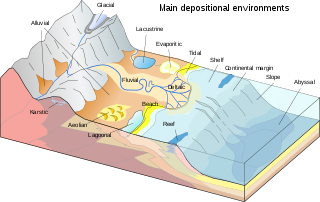User:Mikenorton/sandbox/Depositional environment
| This is not a Wikipedia article: It is an individual user's work-in-progress page, and may be incomplete and/or unreliable. For guidance on developing this draft, see Wikipedia:So you made a userspace draft. Find sources: Google (books · news · scholar · free images · WP refs) · FENS · JSTOR · TWL |

In geology, depositional environment or sedimentary environment describes the combination of physical, chemical and biological processes associated with the deposition of a particular type of sediment and, therefore, the rock types that will be formed after lithification, if the sediment is preserved in the rock record. In most cases the environments associated with particular rock types or associations of rock types can be matched to existing analogues. However, the further back in geological time sediments were deposited, the more likely that direct modern analogues are not available (e.g. banded iron formations).
Types[edit]
The main types of depositional environment are continental, coastal and marine.
Continental[edit]
Deposition in continental environments is controlled by various processes, including mass wasting and erosion by ice, water and wind.
Glacial[edit]
The action of glaciers and icesheets leads to the deposition of sediments in many different environments.
Alluvial[edit]
Fluvial[edit]
Lacustrine[edit]
Deposition in lakes depends on factors such as water depth, sediment input rates, whether there is through drainage or not and the evaporation rate.
Aeolian[edit]
The main aeolian depositional environments are dune systems, interdune areas and sandsheets.
Coastal[edit]
These depositional environments mark the transition from continental to marine.
Shore (beach)[edit]
The shore environment includes the intertidal zone between low and high water and the area beyond that affected by storms, continuing up to one of the normal continental environments.
Lagoonal[edit]
Lagoonal environments develop along coasts, typically where there is a relative rise in sea level, behind a reef or barrier bar. The water within the lagoon is mostly connected with the main water body by way of one or more narrow passages. Depending on water depth, tidal range, evaporation rate and the amount of input into the lagoon from rivers, the water in the lagoon may be anywhere from brackish to hypersaline.
Deltaic[edit]
Deltas form wherever rivers meet with substantial bodies of water. The main environments for deposition are the delta top, the delta slope and the "pro-delta". The delta top environment includes distributary channels with their levees and areas between the channels affected by crevasse-splays. When the channels reach the delta edge, sediment avalanches down forming foresets parallel to the dip of the delta slope. Suspended fine-grained sediment is deposited in front of the active delta, forming pro-delta deposits.
Marine[edit]
Marine depositional environments are generally governed by water depth and the proximity to sediment sources.
Shelf[edit]
The shelf environment is generally characterised by water depths in the range from 0–200 m. In the shallowest part of the shelf the sediments are affected by normal wave action and this is referred to as the upper shoreface. In the next deeper zone, the lower shoreface, sediments are only affected by storm wave action, with the storm wave base being typically in the range 15–40 m. With increasing depth, the environments are known as the inner, middle and outer shelf.
Slope[edit]
Abyssal plain[edit]
Sedimentation on the abyssal plain is dominated by fine-grained material, either brought in by turbidity currents or settling out from suspension. The material is a mixture of mud and silt combined with the remains of creatures living in the water column. Below the calcite compensation depth, the high solubility of carbonates mean that the sediments deposited in these very deep parts are mainly silica derived from radiolaria. As with the slope environment, the sediments may be locally modified by bottom currents, leading to the formation of contourites.

